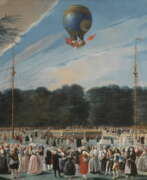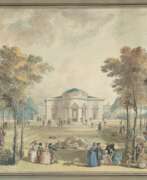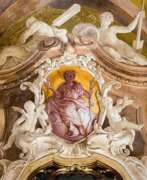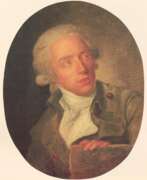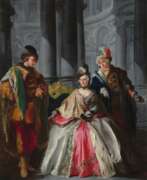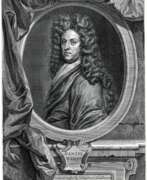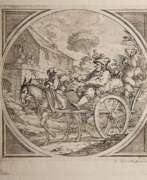Decorators 18th century


Alexei Petrovich Antropov (Russian: Алексей Петрович Антропов), a prominent Russian painter of the Baroque period, is celebrated for his significant contributions to art, particularly in portrait painting and church frescoing. Born into a family connected to the governmental sphere, Antropov's early exposure to the arts came through his work in the Chancellory of Buildings, where he began his career under the guidance of various Russian and foreign artists, including Andrey Matveyev and Ivan Vishnyakov.
Antropov's work is distinguished by his mastery in oil painting, miniatures, and icons, with a career that saw him active mainly in St. Petersburg, Moscow, and Kiev. His artistic journey was notably influenced by his studies with the French court painter Louis Caravaque and later with the Italian painter Pietro Rotari, which helped him refine his portrait artistry. The 1760s emerged as his most productive period, where he crafted numerous notable portraits, including those of Elizabeth Petrovna and Peter III of Russia, showcasing his preference for traditional icon and parsuna portrait styles characterized by sharp contrasts and dark backgrounds.
Antropov's legacy extends beyond his artworks; his dedication to art education and the community is evident in his decision to transfer his only house to the Department of Education for the establishment of a Free School. He passed away in 1795, leaving behind a rich collection of works that continue to be celebrated in museums such as the Tretyakov Gallery in Moscow and the Russian Museum in St. Petersburg.
Collectors and art experts value Antropov for his unique contributions to Russian art, his role in the transition of portrait styles, and his influence on future generations of artists, including his apprentice Dmitry Levitzky. His works, including the portraits of Catherine II and Archbishop Gavriil Petrov, are pivotal in understanding the artistic and cultural shifts of 18th-century Russia.
For those interested in exploring the depths of Russian Baroque art and the significant figures who shaped its contours, Alexei Petrovich Antropov's oeuvre offers a fascinating journey. Collectors and aficionados are encouraged to sign up for updates on new product sales and auction events related to Antropov's works, ensuring they remain informed about opportunities to own a piece of this illustrious artist's legacy. This subscription is a gateway to the vibrant world of art collection, where the beauty of the past is preserved for the future.




Vladimir Lukich Borovikovsky (Russian: Влади́мир Луки́ч Боровико́вский), a distinguished Russian artist of Ukrainian Cossack origin, was renowned for his mastery in portrait painting and ecclesiastical art. Born in Mirgorod, now Myrhorod, Ukraine, in 1757, Borovikovsky lived in Ukraine until the age of 31 before moving to St. Petersburg. His journey into the art world began under unusual circumstances when Empress Catherine II was impressed by his allegorical paintings, leading him to relocate to Saint Petersburg and adopt the more aristocratic surname Borovikovsky.
Borovikovsky's work epitomizes the sentimentalism era, capturing the essence and inner beauty of his subjects with a unique sensitivity and elegance. His ability to convey the nuanced emotions and dignified personalities of his sitters through intimate and detailed portraiture earned him acclaim, particularly among the Russian imperial family and nobility. Throughout his career, he produced about 500 portraits, with 400 surviving today, including notable figures such as Catherine II, Paul I, and Alexander Kurakin, as well as the celebrated "Portrait of M.I. Lopukhina".
In his later years, Borovikovsky's focus shifted towards religious painting, contributing significantly to the Kazan Cathedral and other ecclesiastical sites in St. Petersburg. Despite facing challenges, including court intrigues and a personal struggle with mental discord and alcohol, he left a lasting legacy through his art, which remains highly regarded for its depth, sincerity, and technical skill.
Collectors and experts in art and antiques cherish Borovikovsky's work for its historical significance and profound emotional resonance. His paintings, a fusion of classicist and sentimental styles, continue to inspire and captivate audiences, preserving the legacy of one of Russia's most gifted portraitists.
For updates on exhibitions and auction events featuring Vladimir Lukich Borovikovsky's work, sign up for our newsletter. Stay informed about the latest discoveries and opportunities to add a piece of history to your collection.


François Boucher, a French artist, is celebrated for his significant contributions to the Rococo style of painting. His works are renowned for their idyllic and voluptuous themes, which include classical subjects, decorative allegories, and pastoral scenes. Boucher's talent in creating intricate and charming paintings made him a favorite in the French court, especially with Madame de Pompadour.
François Boucher's skills were not confined to painting alone; he was also an adept draftsman and tapestry designer. His designs for the Beauvais tapestry workshops were highly successful, influencing decorative arts across Europe. Moreover, Boucher's influence extended to porcelain, with his designs being replicated on tableware and decorative pieces at the Vincennes and Sèvres factories.
Despite the later criticism of his style as overly frivolous and disconnected from the emerging Neoclassical trends, François Boucher's works continue to be admired for their aesthetic beauty and historical significance. His ability to blend various elements into a cohesive and appealing visual narrative demonstrates his mastery and enduring legacy in the art world.
For art collectors and enthusiasts, François Boucher's oeuvre offers a fascinating glimpse into 18th-century French art and culture, reflecting the opulence and delicate tastes of the Rococo period. His paintings and designs continue to be celebrated and studied for their artistic merit and historical context.
To stay updated on the latest exhibitions, sales, and events related to François Boucher's works, consider subscribing to updates from reliable art and antique sources. This way, you'll remain informed about opportunities to engage with the art of one of Rococo's most distinguished masters.




Daniel Caffé was a distinguished German pastel painter of portraits. Known for his meticulous craftsmanship and the emotive depth of his portraiture, Caffé initially embarked on a career in architectural decoration before his talents led him to Dresden to become a portrait artist.
Daniel Caffé's journey into the world of fine arts was marked by his study at the Dresden Academy of Fine Arts under the guidance of significant figures like Casanova and the influence of neoclassical artist Anton Raphael Mengs. His mastery of pastel made him a favored portraitist among the nobility and notable figures of his time, including Russian patrons like Prince Beloselski and Admiral Fyodor Grigoryevich Orloff.
His works, celebrated for their detailed and expressive nature, capture the essence of his subjects with striking realism and emotional depth. Among his notable works are portraits of prominent individuals such as Johann George Tromlitz and Karl August von Hardenberg, which not only exemplify his skill but also his contribution to the documentation of his era's influential figures.
Daniel Caffé's legacy as a pastel painter is preserved in various art collections and continues to be admired for its historical significance and artistic merit. He passed away on January 16, 1815, in Leipzig, leaving behind a body of work that continues to be studied and revered in the art community.
For collectors and experts in art and antiques, Daniel Caffé's portraits offer a glimpse into the refined pastel techniques and cultural narratives of the late 18th to early 19th century. His works remain a significant part of German art history, celebrated for their contribution to the development of portrait painting.
To explore more about Daniel Caffé’s life and works, consider signing up for updates on exhibitions and auctions where his art is featured. This will provide opportunities to engage more deeply with the legacy of this notable artist.


Louis Caravaque was a French portrait painter renowned for his contributions to Russian art during the early 18th century. Born in 1684 in Marseilles, France, Caravaque embarked on his artistic journey influenced by his family's background in decorative painting. His talent soon caught the attention of influential figures, leading to a pivotal contract in 1715 that took him to Russia. There, he famously painted Peter the Great and became a favored artist at the Russian court.
Caravaque's work is distinguished by his detailed and expressive portraiture, which earned him the position of the first court painter during Anna Ioannovna's reign. He played a significant role in the cultural exchanges between France and Russia, melding Western European techniques with Russian traditions. His notable works, which include portraits of Russian royalty and nobility, are held in prestigious collections such as the Hermitage and the Russian Museum in St. Petersburg.
Among his most celebrated paintings are the portraits of Peter the Great, Empress Elizabeth as an Olympic goddess, and Catherine II, showcasing his skill in capturing the grandeur and intricacy of his subjects. These artworks not only highlight his mastery of oil painting but also reflect the rich historical and cultural milieu of his time.
For collectors and art experts, the legacy of Louis Caravaque offers a fascinating glimpse into the intersection of French artistic influence and Russian imperial identity. His works remain a testament to his skill and the cultural bridge he helped forge between two distinct worlds.
For more information and to stay updated on exhibitions featuring Louis Caravaque’s work, consider signing up for updates related to this remarkable artist.


Charles-Louis Clérisseau was a French architect, draughtsman, antiquary, and artist who became a leading authority on ancient Roman architecture and Roman ruins in Italy and France. With his influence extending to Russia, England, and the United States, and clients including Catherine the Great and Thomas Jefferson, Clérisseau played a key role in the genesis of neoclassical architecture during the second half of the 18th century.


Pierre-Antoine Demachy was a French painter and master of architectural landscapes.
He studied architecture at the Royal Academy of Painting and Sculpture and specialized in drawing ruins, architectural structures and scenery. Due to his success in his art, he became a royal master of architectural decorations for entertaining events. Demachy also taught students of painting at the Louvre Palace.


Gaspare Diziani was an Italian late Baroque and early Rococo painter, decorator, draftsman, and engraver.
He painted a series of canvases and murals for churches, and worked as a set designer for theaters and opera houses in Venice, Munich, and Dresden. His engravings illustrate the 1757 edition of The Divine Comedy.
Gaspare Diziani was one of the founders of the Venice Academy of Fine Arts.


Domenico Fossati was an Italian artist, painter, architect and stage designer of the second half of the 18th century.
Fossati studied painting at the Academy of Fine Arts in Venice. His works as a set designer and scenographer can be found in the theaters and palaces of Venice, Padua and other Italian cities, as well as at La Scala in Milan. Fossati's folios with his ink sketches of stage sets, details of rococo ornamentation, and drawings of fantastic creatures inhabiting an outlandish world have also survived.


Georg Christoph Grooth was a German painter, renowned for his significant contributions to Russian art in the mid-18th century. Born in Stuttgart on January 21, 1716, Grooth moved to the Russian Empire in 1741, where he quickly became a favored portraitist at the Imperial Court under Empress Elizaveta Petrovna. His work during this period includes supervising and restoring royal painting collections and teaching Russian pupils, one of whom was the talented Ivan Argunov.
Grooth's most celebrated work is the 1743 equestrian portrait of Empress Elizabeth of Russia, which is preserved in the State Tretyakov Gallery in Moscow and has replicas in other major institutions like The Metropolitan Museum of Art. This iconic portrait shows Elizabeth in a green colonel's uniform, symbolizing her command over the Russian military and navy.
His role extended beyond painting; from December 1743, Grooth also served as the Keeper of the Palace art galleries, decorating interiors of palaces and other buildings in St. Petersburg and Tsarskoe Selo. This period marked a prolific phase where he created numerous portraits of the Russian aristocracy until his death on October 8, 1749, in St. Petersburg.
For collectors and experts in art and antiques, Grooth’s works offer a unique glimpse into the 18th-century Russian imperial court and its artistic preferences. Sign up for updates on new product sales and auction events featuring Georg Christoph Grooth’s work to enrich your collection with pieces of historical and artistic significance.
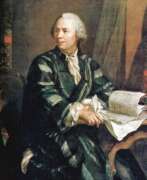

Georg Gsell was a Swiss Baroque painter, art consultant, and art dealer, renowned for his contributions to the arts during the early 18th century. Born in St. Gallen on January 28, 1673, Gsell's journey in the arts took him across Europe. He moved to Amsterdam in 1704, and later to Russia on the invitation of Peter the Great in 1716. In Russia, he served as the first curator of the Imperial art gallery, a significant cultural institution founded in 1720.
Gsell's work is appreciated for its meticulous detail and historical value. He catalogued the Kunstkamera, Russia's first museum, through detailed manuscript forms, a significant contribution to the preservation of early 18th-century European and Russian cultural artifacts. His artworks, which include portraits and still lifes, reflect the Baroque style's complexity and elegance.
For art collectors and experts, Georg Gsell's legacy offers a glimpse into the Baroque period's artistry and the early days of museum curation in Russia. His works and contributions remain subjects of study and admiration in art circles today.
For updates on exhibitions and sales related to Georg Gsell's works, sign up for our newsletter. This subscription will keep you informed about new findings and auction events specifically pertaining to Georg Gsell's art.


Pieter Hardimé was a Flemish painter specializing in floral still lifes. Hardimé created many works depicting bouquets in large stone vases or flowers as garlands for garden decorations. He also worked on decorating walls and ceilings in wealthy homes and created decorative murals.


Gerard de Lairesse was a Dutch painter, printmaker, and art theorist. Known for his classical approach, de Lairesse's work marked a departure from the Baroque style prevalent in the Dutch Golden Age, leaning instead towards the neoclassicism that would dominate European art in the 18th century. His art and theories were deeply influenced by the ideals of beauty, grace, and moral edification, advocating for the selection of the most perfect manifestations of natural phenomena rather than their random imitation.
De Lairesse was not only a prolific painter but also an influential art theorist. His treatises, "Grondlegginge ter teekenkonst" (1701) and "Het groot schilderboeck" (1707), were seminal works that laid down principles of art and aesthetics that influenced not just his contemporaries but also generations of artists to come. He emphasized the importance of adhering to theoretical knowledge and the study of nature, albeit through a lens that filtered out its imperfections, to achieve ideal beauty in art.
Despite facing personal challenges, including a congenital condition that led to the loss of his sight in his later years, de Lairesse remained a central figure in the artistic and intellectual circles of Amsterdam. His lectures, delivered from his home, attracted a wide array of students and enthusiasts, eager to learn from his extensive knowledge and experience.
Today, works by Gerard de Lairesse can be found in prestigious institutions worldwide, including the Rijksmuseum and the Amsterdam Museum in the Netherlands, the Louvre in Paris, the Metropolitan Museum of Art in New York, and the National Gallery in London, among others. His legacy as the 'Dutch Poussin' speaks to his enduring influence on the evolution of European art, bridging the gap between the Baroque and the Neoclassical.
For collectors and experts in art and antiques, Gerard de Lairesse represents an intriguing study in the transition of art styles from the Baroque to Neoclassicism. His dedication to the theory and practice of art makes his work a valuable addition to any collection.
To stay informed about exhibitions, sales, and auction events related to Gerard de Lairesse's work, consider signing up for updates. This will ensure you are always up to date with the latest opportunities to engage with the remarkable legacy of this influential Dutch artist.


Nicolas Lancret was a French painter. Born in Paris, he was a brilliant depicter of light comedy which reflected the tastes and manners of French society during the regency of the Duke of Orleans and, later, early reign of King Louis XV.


Jacob Leyssens / Lyssens was a Flemish painter and decorator. After training in Antwerp, he spent a long time in Rome. After his return to Antwerp, he was active as a painter and decorator and collaborated with prominent Antwerp still life painters such as Gaspar Peeter Verbruggen the Younger and Jan Baptist Bosschaert. He became a member of the Bentvueghels, an association of mainly Dutch and Flemish artists working in Rome. Only a few of his works are known, one of which is in the collection of the Hermitage Museum in Saint Petersburg. He decorated many rooms and ceilings in prominent residences and buildings in Antwerp. He is known to have collaborated as a staffage painter with other artists.


Jean-Baptiste Pillement was a French painter and designer, known for his exquisite and delicate landscapes, but whose importance lies primarily in the engravings done after his drawings, and their influence in spreading the Rococo style and particularly the taste for chinoiserie throughout Europe.


John Francis Rigaud was an English painter of French origin.
He studied painting in Italy and later became an academician at the Royal Academy of Arts in London. Rigo was a decorator and painted portraits and paintings on historical, mythological, religious themes and allegories.


Alessandro Sanquirico was an Italian painter, scenographer, set designer and architect.
Sanquirico began his work as a decorator for festive celebrations in Milan. In addition to scenography, Sancuirico studied architecture and perspective with Giuseppe Piermarini, architect of the La Scala opera house. Between 1817 and 1832, Sanquirico was La Scala's chief scenic designer and skillfully used the neoclassical architectural style in his sets, as well as images of exotic locations. The scenography created by Sanquirico for La Scala reached a higher level than contemporary designs for opera houses in any other European country. For 15 years he was the sole scenographer, designing sets for productions of operas by Donizetti, Rossini, Bellini, Mozart, Meyerbeer and Pacini. In total, Sanquirico designed more than 300 productions for this theater, including many premieres.
Sanquirico also created several large-scale paintings of historical subjects, worked on the interior of Milan Cathedral and fulfilled other commissions from wealthy nobles.


Christian Georg Schütz the Elder, born in 1718 in Flörsheim am Main and passing in 1791 in Frankfurt am Main, was a German painter whose etchings and landscapes left a timeless mark on the world of art. Schütz emerged as a master of capturing the natural beauty and architectural elegance of his homeland.
His works, which often depicted vibrant market scenes, serene river landscapes, and bucolic countryside views, reflect a deep understanding of light and atmosphere. Noteworthy pieces like "The Liebfrauenberg in Frankfurt" and "River Landscape with Barge" showcase his ability to blend human activity seamlessly with natural surroundings. His legacy continues to inspire, with 28 of his works proudly displayed at the Städel Museum, offering a window into the pastoral grace of 18th-century Germany.
For those drawn to the idyllic scenes of historical Europe, Schütz's paintings are a cultural treasure. His influence extended to his children and pupils, ensuring that the Schütz legacy of artistry would endure.
Explore Schütz's vision by visiting the Städel Museum, and stay informed about exhibitions and available works by signing up for our exclusive updates.


Christian Gottlieb Steinlen, also known as Théophile Steinlein, was a Swiss painter, watercolorist, illustrator and engraver.
Steinlein created many views of Vevey's surroundings and taught at the Vevey College of Fine Arts. He was responsible for the design of the official album for Vevey's grand celebration, the 1833 Winegrowers' Festival, and was also the designer of the participants' costumes and decorations. The official booklet he created included several wood-engraved illustrations as well as two sets of thirty engraved plates.
The artist Theophile Alexander Steinlen (1859-1923) was the grandson of Christian Gottlieb Steinlen.


Peter Tillemans was a Flemish painter who worked in England.
Arriving in England in 1708, he quickly established himself as a versatile painter, receiving commissions for portrait groups, historical subjects, theater sets, and decorative painting.
In the early 1720s, Tillemans had a successful career painting dogs, horses, and racing scenes and was one of the first artists to depict sporting scenes in England. He also specialized in country house views and panoramic landscapes with sporting events in the foreground. Along with John Wootton and James Seymour, Tillemans is believed to have been one of the founders of the English school of sports painting.
Some two hundred topographical drawings of Northamptonshire by the artist have also survived.
Tillemans was a member of the Rose and Crown Club.


Stefano Torelli was an Italian painter, born in 1712 in Bologna. Renowned for his mastery in the Rococo style, Torelli initially trained under his father, Felice Torelli, and later under Francesco Solimena. His career flourished after being invited by Augustus III, the future King of Poland, to Dresden in 1740. There, he contributed significantly to decorating the royal palaces with altar-pieces, ceiling paintings, and collaborating with artists like Canaletto on views of Dresden.
Torelli's notable works include the "Portrait of Empress Catherine II" and the "Coronation of Catherine II", both reflecting his keen ability to blend opulence with intricate detail, a hallmark of the Rococo period. These works are celebrated for their artistic merit and are held in high esteem at institutions like The Russian Museum and The Tretyakov Gallery.
After his time in Dresden, Torelli was summoned to Russia in 1762, where he became a significant figure at the Russian court. His Russian period was marked by extensive contributions to palace decorations and portraits of royalty and nobility, enhancing his reputation and influence in the art world of his time.
For collectors and experts interested in Stefano Torelli's works, his paintings can be viewed at major museums, and reproductions are available for those wishing to own a piece inspired by his artistry. For updates on exhibitions and sales related to Stefano Torelli's works, signing up for dedicated newsletters can be a valuable resource.


Dirk van der Aa, also known as Theodorus van der Ha or Thierry van der Aa, was a Dutch Rococo painter, graphic ornamentalist. He was a member of the Guild of St. Luke in The Hague. He was primarily an interior painter and became known for his painterly decorative allegories and works executed in monochrome grisaille technique.


Vincent Jansz van der Vinne was a Dutch Golden Age landscape painter, member of the Guild of St. Luke in Haarlem, known for his Italian landscapes and floral still lifes, but also for creating tapestries and decorating entire rooms. Wynne was an art collector and dealer, as well as a museum manager.


Ivan Yakovlevich Vishnyakov (Russian: Ива́н Я́ковлевич Вишняко́в) was a distinguished Russian artist, celebrated for his contributions to painting. As a prominent figure in the realm of culture and art, Vishnyakov's works are a testament to the rich tapestry of Russian heritage, bridging the gap between tradition and innovation in the art world.
Vishnyakov specialized in painting, bringing scenes of Russian life, portraiture, and religious themes to life with a vibrancy and detail that was unparalleled in his time. His ability to capture the essence of his subjects made him a favored artist among the Russian nobility and the Orthodox Church. Vishnyakov's paintings are known for their depth, realism, and emotional expressiveness, qualities that have ensured his lasting legacy in the world of art.
Several of Vishnyakov's masterpieces are housed in prestigious museums and galleries, offering art lovers and collectors a glimpse into the soul of 18th-century Russia. His works not only reflect the aesthetic sensibilities of the period but also provide valuable insights into the cultural and societal norms of his time.
For collectors and experts in art and antiques, Vishnyakov's oeuvre represents an invaluable link to Russia's artistic past. His contributions to painting and sculpture continue to inspire and captivate audiences, underscoring the timeless appeal of his art.
To stay informed about new product sales and auction events featuring works by Ivan Yakovlevich Vishnyakov, we invite you to sign up for updates. This subscription is your gateway to exploring the exquisite beauty of Russian art and ensuring you never miss an opportunity to enrich your collection with pieces of significant historical and cultural value.


Feodosy Ivanovich Yanenko (Russian: Феодосий Иванович Яненко) was a Russian artist born in 1762 and notable for his contributions to religious and portrait painting. Trained at the Imperial Academy of Arts under Gabriel Ignatievich Kozlov, Yanenko's talent was recognized early in his career. In 1795, he was assigned to the Academy for his studies of the naked human figure, and by 1797, his painting "Travellers in a Storm" earned him the rank of academician.
Yanenko is best known for his religious artworks, including several images for the Kazan Cathedral in St. Petersburg. His prowess in portrait painting is exemplified by his work housed in the Tretyakov Gallery, Moscow—a portrait of Emperor Paul I when he was Crown Prince, painted in 1798.
His works are cherished for their historical significance and artistic quality, making them of great interest to collectors and art historians alike. For those passionate about Russian art from the late 18th century, Yanenko's contributions remain an essential part of the discussion.
For updates related to new product sales and auction events featuring Feodosiy Ivanovich Yanenko's works, consider signing up for our newsletter. This subscription will keep you informed about all the latest developments and opportunities to acquire pieces by this distinguished artist.


Antonio Pietro Francesco Zucchi or Antonio Zucchi was an Italian painter, printmaker and printmaker of the Neoclassical period and a member of the Academy of Fine Arts in Venice and the Royal Academy of Arts in Great Britain. He was engaged in altarpiece, wall painting, and worked as an artist-decorator. Antonio was the son of the engraver Francesco Zucchi and the younger brother of the engraver Giuseppe Zucchi.




















